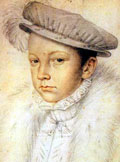 |
François
b. 19 Jan 1544, Fontainebleau, France [1]
d. 5 Dec 1560, Orléans, France [2] |
| Title: |
Dei gratia rex et regina Scotorum delphinus et delphina Viennenses = By the grace of God, King and Queen of the Scots, Dauphin and Dauphine of Viennois (joint style for Franciscus et Maria = François and Mary) [3][4] |
| Term: |
24 Apr 1558 - 10 Jul 1559 |
| Chronology: |
24 Apr 1558, assumed royal style upon marriage to Mary I, Queen of the Scots, Paris, France [5] |
|
29 Nov 1558, granting of "crown matrimonial" upon marriage is consented to by an Act of Parliament [6] |
| Title: |
Dei gratia rex et regina Francie et Scotie = By the grace of God, King and Queen of France and Scotland (joint style for Franciscus et Maria = François and Mary) [4][7] |
| Term: |
10 Jul 1559 - 5 Dec 1560 |
| Chronology: |
10 Jul 1559, royal style changed upon accession to the throne of France as François II |
|
5 Dec 1560, died |
| Names/titles: |
Baptised (Chapelle Saint-Saturnin, Fontainebleau, 10 Feb 1544): François; private name: François de France; premier fils de France et dauphin de Viennois (First Son of France and Dauphin of Viennois) [31 Mar 1547 - 10 Jul 1559] |
| Biography: |
| Son of Henri duc d'Orléans (future King Henri II of France) and Caterina Maria Romola di Lorenzo de' Medici (French: Catherine de Médicis); became heir apparent to the throne of France after the accession of his father as Henri II (31 Mar 1547); married (Paris, 24 Apr 1558) Queen Mary I of Scotland, daughter of King James V of Scotland and Marie de Guise (also known as Mary of Lorraine); although the Parliament of Scotland did not proclaim him as king, it consented to granting "crown matrimonial" (29 Nov 1558) with the right to reign should his wife predecease him; succeeded his father (10 Jul 1559) at the age of 15; was moved by his wife's uncles, François duc de Guise and Charles cardinal de Lorraine, from the Hôtel des Tournelles to the Louvre (11 Jul 1559); issued letters patent to his mother (15 Aug 1559) granting her half of payments to the Crown and requiring all official acts to be approved by her; issued Edict of Amboise (2 Mar 1560, registered by Parlement 11 Mar 1560) which pardoned all religious crimes under condition of abjuration, excluded Protestant ministers and those convicted of conspiracy against the Crown; was attacked at Château d'Amboise by Protestant conspirators (16 Mar 1560) intending to arrest François and Charles de Guise and put the king and his family into protective custody; conspirators were defeated by François de Guise; issued pardons for conspirators who claimed their intention was to petition the king only; executed 1,200 leaders (17 Mar 1560); arrested Louis de Bourbon, prince de Condé, as suspected instigator of the Amboise Conspiracy (convicted and sentenced to death by tribunal 26 Nov 1560, but sentence never carried out); issued Edict of Romorantin (presented to Parlement in May 1560) assigning heresy trials to Catholic Church jurisdiction and illegal assemblies to presidial court jurisdiction (not registered by Parlement); Treaty of Edinburgh signed (6 Jul 1560) officially recognizing Elizabeth I as Queen of England and relinquishing claim to English throne; special meeting of royal council at Fontainebleau convoked by Caterina (Aug 1560) to reduce tension between Catholic and Huguenot factions; convoked meeting of Estates-General to mediate secular problems of religious conflict, but died (5 Dec 1560) before the assembly met 13 Dec 1560 at Orléans. |
| Biographical sources: "Mary, Queen of Scots, Her Environment and Tragedy: a biography", by Thomas Finlaysen Henderson (New York: Charles Scribner's Sons, 1905); "Mary Queen of Scots", by Antonia Fraser (New York: Delacorte Press, 1969). |
| |
| [1] |
"Catherine de Medici: Renaissance Queen of France", by Leonie Frieda (New York: HarperCollins, 2003); "One King, One Faith", by Nancy Lynn Roelker (Berkeley: University of California Press, 1996). |
| [2] |
"Dictionnaire de Biographie Française", (Paris: Letouzey et Ané, 1979), vol. 14. |
| [3] |
Sometimes: Dei gratia rex et regina Scotie delphinus et delphina Viennenses = By the grace of God, King and Queen of Scotland, Dauphin and Dauphine of Viennois. |
| [4] |
Between the death of Queen Mary I of England (17 Nov 1558) and ratification of a peace treaty with England (28 May 1559), François and Mary occasionally styled themselves 'By the grace of God, of Scotland, England, and Ireland, King and Queen', although this style had no statutory authority; after the accession of François II (10 Jul 1559), the claim was renewed and the Great Seal of Scotland bore a legend: FRANCISCUS ET MARIA D[ei] G[ratia] R[ex et] R[egina] FRANCOR[um] SCOT[orum] ANGL[ie] ET HYBER[nie]; following the signing of the Treaty of Edinburgh (6 Jul 1560) between France, England and Scotland, the claim was abandoned, although Mary never conceded to ratification. |
| [5] |
Facsimiles of National Manuscripts of England, 3 (no. XXXVIII). |
| [6] |
Acts of the Parliaments of Scotland, 2 (nos. 506-507). |
| [7] |
On coins: Dei gratia Rex et Regina Francorum Scotorumque = By the grace of God, King and Queen of the French and the Scots |
|
Image: portrait by François Clouet. |